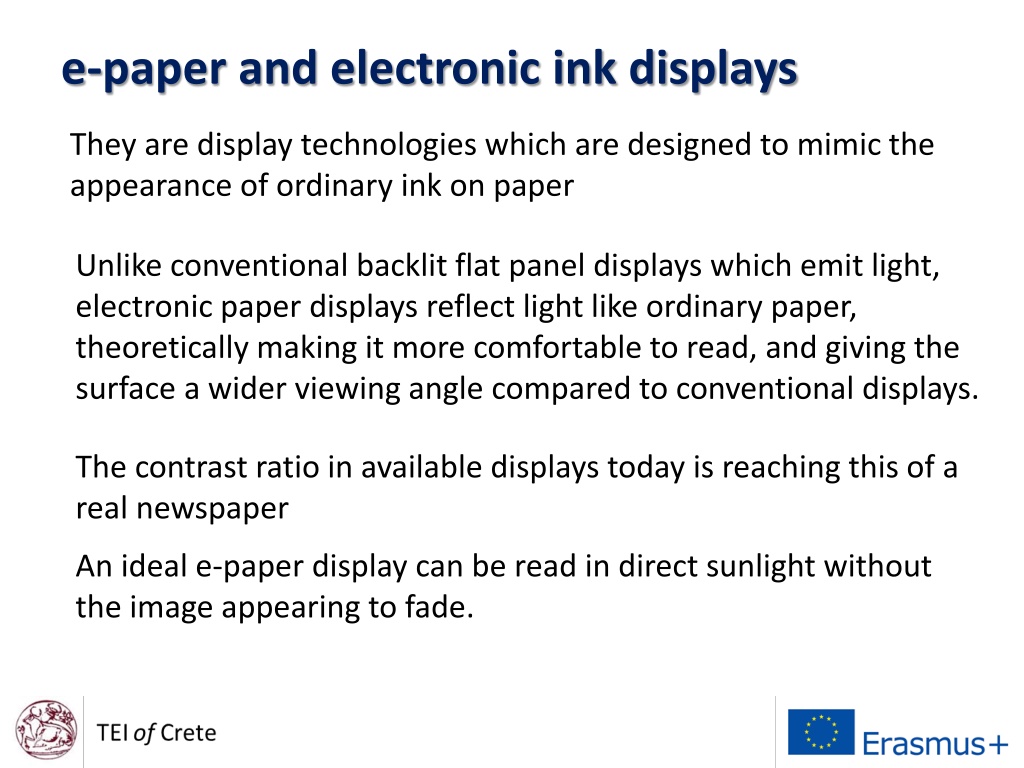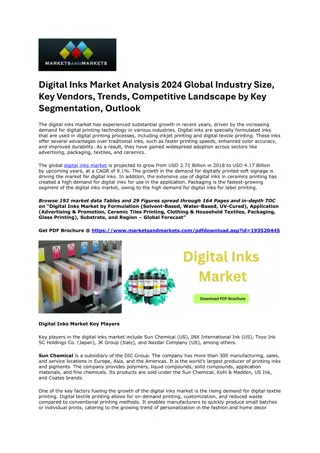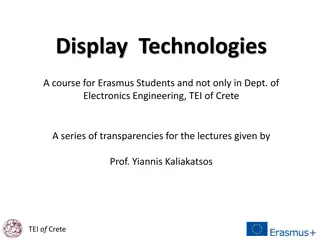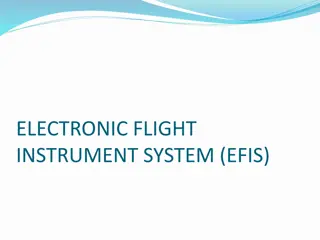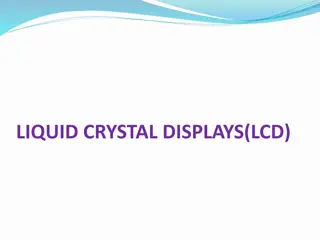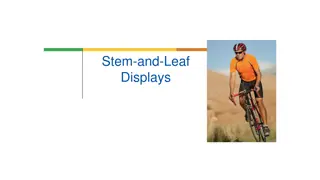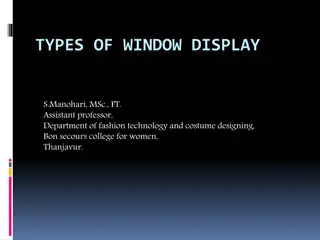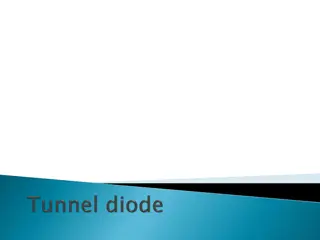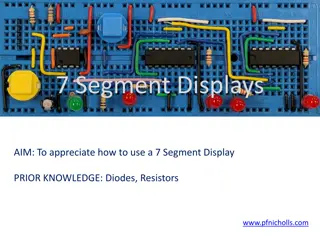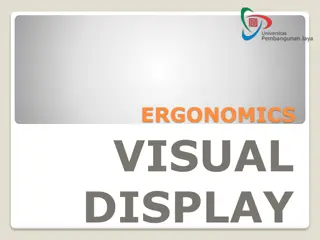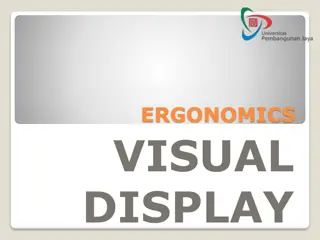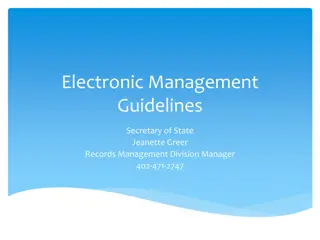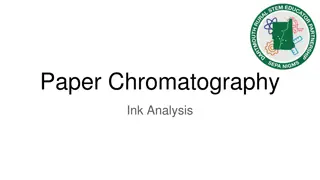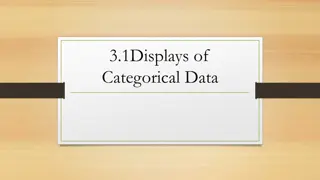e-paper and electronic ink displays
E-paper and electronic ink displays replicate the look of ink on paper, reflecting light like ordinary paper for comfortable reading. They boast high contrast ratios and wide viewing angles, making them ideal for various applications. Examples include the Amazon Kindle, showcasing characteristics like reflectivity, grayscale capability, and image update time. Learn how e-paper screens work from informative videos provided in the content.
Download Presentation

Please find below an Image/Link to download the presentation.
The content on the website is provided AS IS for your information and personal use only. It may not be sold, licensed, or shared on other websites without obtaining consent from the author. Download presentation by click this link. If you encounter any issues during the download, it is possible that the publisher has removed the file from their server.
E N D
Presentation Transcript
e-paper and electronic ink displays They are display technologies which are designed to mimic the appearance of ordinary ink on paper Unlike conventional backlit flat panel displays which emit light, electronic paper displays reflect light like ordinary paper, theoretically making it more comfortable to read, and giving the surface a wider viewing angle compared to conventional displays. The contrast ratio in available displays today is reaching this of a real newspaper An ideal e-paper display can be read in direct sunlight without the image appearing to fade.
e-paper and electronic ink displays The contrast ratio is a property of a display system, defined as the ratio of the luminance of the brightest color (white) to that of the darkest color (black) that the system is capable of producing. For example, a contrast ratio of 1000:1 means that the brightness of a completely white image is 1000 times greater than the brightness of a completely black image. Screens with a high contrast ratio, such as 100,000:1, have darker black levels than screens with lower contrast ratios, such as 1000:1 A higher contrast ratio also produces images with more saturated colors since the difference between black and white is greater. A high contrast ratio is a desired aspect of any display.
e-paper and electronic ink displays Contrast Ratio Comparison in the Dark
e-paper and electronic ink displays Contrast Ratio Comparison in Daylight
The well known Kindle from Amazon introduced in 2007 is an example of e-paper
Some characteristics of e-displays Vizplex Pearl Carta White State Reflectivity: 40% (typical) 70% (minimum) 74% Dark State Reflectivity 24% (maximum) 19% Contrast Ratio: 7:1 (typical) 10:1 (minimum) 15:1 Viewing Angle: 180 near 180 near 180 Reflective 40.7% (minimum) 44% Grayscale Capability: 4-bit (16 gray levels) 4-bit, 16 gray levels 4-bit 740 ms (grayscale mode) 260 ms (1-bit mode) 600 ms (grayscale) 120 ms (1 bit) 450 ms (grayscale) 120 ms (1 bit) Image Update Time: Resolution 200 ppi max 200 ppi plus 300 ppi plus
How e-paper screens work https://www.youtube.com/watch?v=6NRT8E5-reM&t=7s&ab_channel=Pocketnow https://www.youtube.com/watch?v=h11TXa5a_PQ&ab_channel=Gizmodo https://www.youtube.com/watch?v=8xvxJO3xr_s&feature=emb_rel_paus e&ab_channel=Techquickie
Electrophoresis Electrophoretic display Electrophoresis is the migration of charged colloidal particles or molecules through a stationary medium under the influence of an applied electric field usually provided by immersed electrodes
In display, titanium dioxide (titania) particles approximately one micrometer in diameter are dispersed in a hydrocarbon oil. the simplest implementation of an electrophoretic A dark-colored dye is also added to the oil, along with surfactants and charging agents that cause the particles to take on an electric charge. This mixture is placed between two parallel, conductive plates separated by a gap of 10 to 100 micrometers.
When a voltage is applied across the two plates, the particles will migrate electrophoretically to the plate bearing the opposite charge from that on the particles. Using active matrix driving, a single pixel can be addressed, meaning that the bottom electrode can be made either positive or negative compared to the top-electrode.
When the particles are located at the front (viewing) side of the display, it appears white, because light is scattered back to the viewer by the high-index titania particles. When the particles are located at the rear side of the display, it appears dark, because the incident light is absorbed by the colored dye.
If the rear electrode is divided into a number of small picture elements (pixels), then an image can be formed by applying the appropriate voltage to each region of the display to create a pattern of reflecting and absorbing regions. Electrophoretic displays are considered prime examples of the electronic paper category, because of their paper-like appearance and low power consumption.
Electrophoretic displays are considered prime examples of the electronic paper category, because of their paper-like appearance and low power consumption. Zoomed image of an electrophoretic display Electrophoretic displays can be manufactured using the Electronics on Plastic by Laser Release (EPLaR) process developed by Philips Research to enable existing AM-LCD manufacturing plants to create flexible plastic displays.
Examples of commercial electrophoretic displays include the high- resolution active matrix displays used in the Amazon Kindle, Barnes & Noble Nook, Sony Librie, Sony Reader, Kobo e-Reader and iRex iLiad e- readers. These displays are constructed from an electrophoretic imaging film manufactured by E Ink Corporation.
Another alternative principle for electronic ink is based on spherical ink particles with opposite charges and colors at both sides. By applying an electric field, the particles rotate and hence change color
What are the advantages of Electrophoretic Displays ? High reflectivity of the white state and high contrast: Electrophoretic ink uses basically the same pigments as in regular ink for books, newspapers, etc. Therefore ED's have the same agreeable readability as printed paper. High resolution: The current resolution is about 170 pixels per inch, which is similar to the current LCD monitors for instance. Excellent readability in direct sunlight and in dimmed light under all angles. Very low energy consumption: There is no need of a backlight that is the main energy consumer in most displays. Energy consumption is 1/10 to 1/100 of a regular LCD display. Possibility of thin, mobile and flexible displays:
Some recent new applications using the principle of electrophoretic ink. Prototypes of flexible displays (Fujitsu) Bendable clock (E ink)
Rollable display, the "Readius" (Philips) Flexible newspaper (Philips)
USB flash drive with E Ink- implemented capacity meter of available flash memory Tram timetables on e-paper. Prague, prototype from May 2019.
Color e-reader display Principle of operation of Mirasol color e-display
The magic behind the full-color electronic paper display runs close to the technology of the tri-color screen. The only difference is that the micro cup now contains four different pigments instead of three: yellow, cyan, magenta and white.
https://www.youtube.com/watch?v=81iiGWdsJgg (plastic display) https://www.youtube.com/watch?v=ZY8IFu6-lCc (textbooks) https://www.youtube.com/watch?v=P6sfvTMAtdI
https://www.electronicdesign.com/displays/designing-low-power-displays-battery-powered-iothttps://www.electronicdesign.com/displays/designing-low-power-displays-battery-powered-iot https://www.smartcity-displays.com/how-does-e-paper-work/ https://www.electronicdesign.com/embedded-revolution/11-myths-about-e-paper-displays
